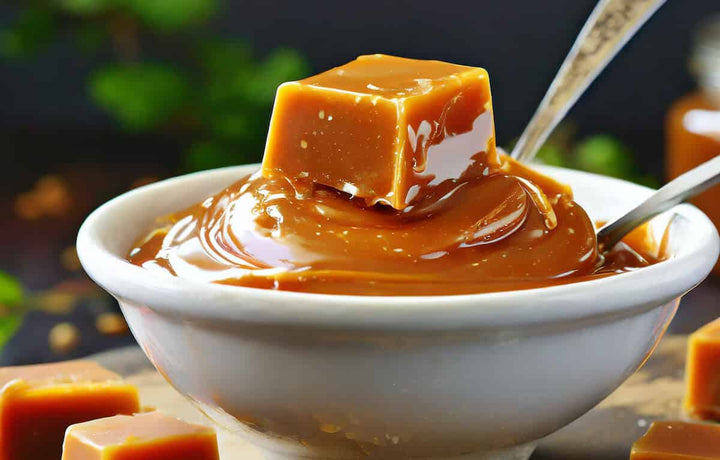Turkish Delight, or Lokum as it is known in its homeland, stands as a jewel in the crown of Turkish cuisine, a confection that whispers tales of opulence and tradition from the Ottoman Empire to the modern-day.
This sweet treat has captivated taste buds for centuries with its soft, chewy texture and flavours, from rosewater and lemon to mastic and pomegranate, each piece dusted with a fine veil of icing sugar or desiccated coconut to prevent sticking.
Beyond its delightful taste, Turkish Delight holds a special place in cultural celebrations, often served with coffee or tea as a gesture of hospitality to guests or during festive occasions.
Click here to sample our coffee-flavoured chocolates...
What is Turkish Delight?
Turkish Delight, known as Lokum in Turkey, is a traditional confection that has been a staple of Turkish cuisine for centuries.
This beloved sweet is made from a simple mixture of sugar and starch, boiled until it reaches a sticky, gel-like consistency.
Once set, the mixture is cut into small, bite-sized cubes and often dusted with icing sugar, powdered cream of tartar, or copra (dried coconut flakes) to prevent sticking.
The result is a soft, chewy treat that melts delightfully in the mouth.
The origins of Turkish Delight date back to the Ottoman Empire, with some accounts suggesting its creation was commissioned by a sultan in search of a new sweet to please his many wives.
Its popularity quickly spread beyond the palace walls and throughout the empire, eventually reaching Western Europe in the 19th century, where it was named "Turkish Delight."
One of the unique aspects of Turkish Delight is its versatility in flavours.
While the traditional version is flavoured with rosewater, modern varieties include various flavours such as lemon, orange, pomegranate, mint, and even chocolate.
Nuts like pistachios, hazelnuts, or walnuts are often embedded within the candy, adding a delightful crunch to the soft texture.
It is traditionally served during religious festivals such as Ramadan and Eid and on special occasions like weddings and engagements.
It is also a common practice to offer Turkish Delight to guests as a symbol of hospitality, often accompanied by Turkish tea or coffee.
In addition to its cultural and historical significance, Turkish Delight has also made its way into popular culture, most famously mentioned in C.S. Lewis's "The Chronicles of Narnia," where it tempts the character Edmund Pevensie into betraying his siblings.

What is Turkish Delight Made Of?
The main ingredients are sugar, water, and starch (usually cornstarch or wheat starch), which provide a sweet flavour and gel-like consistency.
Flavourings such as rosewater, lemon, orange, and others are added, along with acid (like lemon juice or cream of tartar), to ensure a smooth texture by preventing sugar crystallisation.
Food colourings may also be used to enhance the appearance.
Ingredients can include nuts like pistachios, walnuts, and hazelnuts for texture and flavour and dried or candied fruits.
Once formed into pieces, Turkish Delight is typically coated in icing sugar, powdered cream of tartar, or finely ground copra to prevent sticking.
What Flavour is Turkish Delight?
Turkish Delight has many flavours, ranging from traditional to more modern.
The versatility of flavours is one aspect that makes Turkish Delight so unique and beloved worldwide.
Here are some of the most common and popular flavours:
Traditional Flavours
-
Rosewater: Perhaps the most classic and iconic flavour of Turkish Delight. It offers a floral and fragrant taste that is instantly recognizable.
-
Lemon: Another traditional flavour, offering a citrusy and refreshing twist to the sweet treat.
-
Mastic: A resin from the mastic tree, providing a pine-like, slightly bitter flavour. It is a unique taste that is particularly popular in the Eastern Mediterranean.
-
Orange: Like lemon, orange-flavoured Turkish Delight offers a sweet, citrusy taste.
-
Bergamot: Known for its use in Earl Grey tea, bergamot offers a distinctly floral and citrusy flavour.
Nutty Flavours
-
Pistachio: Pieces of pistachio nuts embedded in the delight, providing a crunchy texture and a nutty taste.
-
Hazelnut: Like pistachio, hazelnut adds a rich and nutty flavour, often paired with other flavours like chocolate.
-
Walnut: Offers a more robust nutty taste than pistachio and hazelnut, often complemented by other flavours.
Fruity Flavours
-
Pomegranate: A modern take on Turkish Delight, offering a tart and sweet flavour that pairs well with nuts like pistachio.
-
Strawberry: A sweet and fruity option, often brightly coloured and sometimes paired with cream flavours for a dessert-like taste.
Other Flavours
-
Mint: Provides a refreshing and cool taste, often dyed green and popular for its crisp flavour.
-
Cinnamon: Offers a warm and spicy flavour, a less common but traditional option.
-
Chocolate: A more contemporary flavour, combining the rich taste of chocolate with the soft texture of Turkish Delight.
-
Coffee: Another modern flavour that appeals to coffee lovers, offering a rich and aromatic taste.

How is Turkish Delight Made?
The commercial production of Turkish Delight, while retaining the essence of traditional methods, has been adapted and scaled up to meet high demand and ensure consistency in quality and flavour.
The process involves several key stages, leveraging modern machinery and technology to achieve efficiency and precision.
1. Ingredient Mixing
The process begins with the preparation of the sugar syrup.
Sugar and water are mixed in large industrial boilers.
The exact proportions and the temperature are carefully controlled to achieve the desired consistency.
For some recipes, glucose syrup is also added to prevent crystallisation.
2. Starch Solution Preparation
Separately, a starch solution is prepared by mixing starch (commonly cornstarch) with water.
This mixture is then combined with the sugar syrup under heat.
The starch is a thickener, giving Turkish Delight its characteristic gel-like texture.
3. Cooking
The combined mixture is cooked at a controlled temperature until it reaches the correct consistency.
This stage is crucial as it determines the texture of the final product.
The cooking process is closely monitored, sometimes with the help of automated systems, to ensure precision.
4. Flavouring and Colouring
Once the mixture has cooked and thickened, flavourings and colourings are added.
This could include natural flavours like rosewater, lemon, or mint and colours to match the intended flavour of the Turkish Delight.
In commercial settings, flavours and colours are often pre-measured to maintain consistency across batches.
5. Pouring and Setting
The hot mixture is then poured into large, shallow trays dusted with powdered sugar and cornstarch to prevent sticking.
The trays are left to cool and set, taking several hours.
In some factories, cooling tunnels are used to speed up this process.
6. Cutting
Once set, the Turkish Delight is cut into its traditional small cube shapes.
Commercial producers use machines equipped with sharp blades that can quickly and uniformly cut the large slabs of Turkish Delight into individual pieces.
7. Coating
The cut pieces are then coated in a dusting of powdered sugar, powdered cream of tartar, or desiccated coconut to prevent them from sticking together.
This is often done using a tumbling machine that evenly coats each piece.
8. Packaging
Finally, the Turkish Delight is packaged.
This can range from simple plastic wraps for bulk sales to ornate boxes for gift packages.
Packaging is typically done using automated machinery that weighs, fills, and seals the packages.
9. Quality Control
Throughout the production process, quality control is paramount.
Samples from each batch are tested for texture, flavour, and appearance to ensure they meet the company's standards.
Is Turkish Delight Good for You?
Turkish Delight primarily consists of sugar, water, starch, flavourings, and, in some variations, nuts or fruits.
Here's a closer look at its nutritional aspects and what they mean for your health:
Nutritional Content
-
Sugar: The main ingredient, sugar contributes the majority of calories in Turkish Delight. High sugar intake can lead to various health issues, including weight gain, dental problems, and an increased risk of chronic diseases like type 2 diabetes and heart disease if consumed in large quantities over time.
-
Starch: Used as a thickener, starch adds to the carbohydrate content of Turkish Delight. While it helps achieve the candy's signature texture, it also contributes to the overall calorie count.
-
Nuts and Fruits: Varieties of Turkish Delight that contain nuts or fruits can offer some nutritional benefits, such as vitamins, minerals, and healthy fats, particularly from nuts like pistachios or walnuts. However, these are typically present in small amounts and do not significantly offset the high sugar content.
-
Flavourings: Natural flavourings like rosewater or lemon add minimal calories but can provide antioxidants, depending on the type and amount used.
Health Considerations
-
Calories: Turkish Delight is calorie-dense, meaning it provides a high number of calories in a relatively small portion, primarily from sugars and carbohydrates.
-
Dietary Fibre: Traditional Turkish Delight contains little to no dietary fibre essential for healthy digestion.
-
Additives: Commercially produced Turkish Delight may contain artificial colours and flavours, which some people prefer to avoid.
Moderation is Key
Enjoying Turkish Delight in moderation is the best approach if you're concerned about its health implications.
For those monitoring their sugar intake, looking for varieties with nuts or opting for those made with natural sweeteners might provide a slightly healthier option.
Does Turkish Delight Contain Gelatine?
Traditional Turkish Delight, known as Lokum, does not contain gelatine.
Its soft, chewy texture is achieved through starch, typically cornstarch or wheat starch, and sugar, boiled until they reach the desired consistency.
This makes traditional Turkish Delight suitable for vegetarians, vegans and those following a halal diet, as it does not include animal-derived ingredients.
However, it's worth noting that some modern variations of Turkish Delight produced outside of Turkey or by certain manufacturers might include gelatine as a thickening agent to achieve a different texture or to reduce production costs.
Gelatine, derived from animal collagen, is not a traditional ingredient in Turkish Delight.
Still, its use in some recipes means that those adhering to vegetarian, vegan, or specific religious dietary laws should check the ingredient list carefully.
Can Vegans Eat Turkish Delight?
Vegans can eat traditional Turkish Delight, typically made from sugar, water, starch, flavourings, and sometimes nuts or fruits, without animal-derived ingredients like gelatine.
However, checking the ingredient list for modern variations, including non-vegan additives, is advisable.
Can Vegetarians Eat Turkish Delight?
Vegetarians can eat traditional Turkish Delight from plant-based ingredients like sugar, water, starch, and flavourings without animal-derived products like gelatine.
What Does Turkish Delight Taste Like?
Traditionally, it has a soft, chewy texture and is mildly sweet, with the most classic flavour being rosewater, which imparts a delicate, floral taste that's distinctively light and fragrant.
Lemon and orange varieties provide a citrusy freshness, while mastic brings a slightly piney and resinous flavour, unique to this particular type of Turkish Delight.
Nuts such as pistachios, walnuts, or hazelnuts add a crunchy texture and a rich, nutty undertone that complements the sweetness of the confection.
Modern variations might include pomegranate for a tart and fruity taste or cinnamon and mint for a spicy or refreshing kick, respectively.
The confection is often dusted with icing sugar or coconut, adding a slight graininess contrasting with the smooth, gel-like interior.
Where Can You Buy Tasty Chocolate?
Whitakers Chocolates, renowned for our long history in crafting delicious and affordable chocolates, offers a range of options suitable for everyone, including vegetarian, vegan, and gluten-free choices.
Our top-selling products, such as indulgent Coffee Creams, Neapolitans, Chocolate Wafer Thins, Stem Ginger and Luxury Chocolate Truffles, are perfect for enhancing your mocha coffee experience.
Click here to see our full range of delicious chocolates…
Some Notes From an Expert Chocolatier
I enjoy combining chocolate with sweet confectionery ingredients during creation.
It's a culinary adventure that allows me to explore endless possibilities and push the boundaries of flavour.
Whether infusing rich caramel, tangy fruit jellies, or delicate Turkish Delight into my chocolates, each addition brings unique character and complexity to the final product.
One of the most rewarding aspects of my craft is experimenting with different flavour profiles and textures, striving to create chocolates that tantalise the taste buds and evoke a sense of delight with every bite.
Final Notes On Turkish Delight
Turkish Delight is a cherished delicacy with a rich history and a tantalizing array of flavours.
From its humble origins in the royal courts of the Ottoman Empire to its widespread popularity in modern times, Turkish Delight has enchanted palates with its soft, chewy texture and delicate sweetness.
This timeless confection embodies the artistry and craftsmanship of traditional sweet-making, offering a sensory journey through a symphony of flavours and aromas.
Whether infused with the floral notes of rosewater, the zesty tang of lemon, or the earthy richness of nuts, each bite of Turkish Delight transports the palate to a world of indulgence and delight.
Beyond its culinary allure, Turkish Delight holds a special place in cultural traditions, often shared during festive occasions and celebrations as a symbol of hospitality and generosity.











